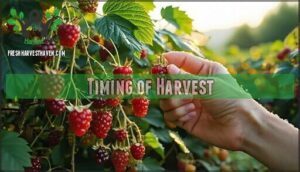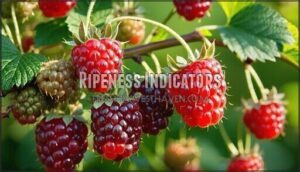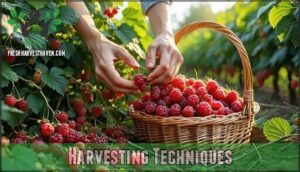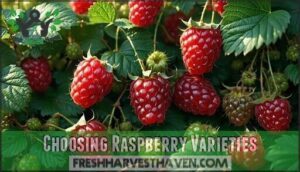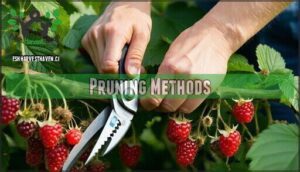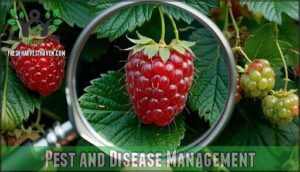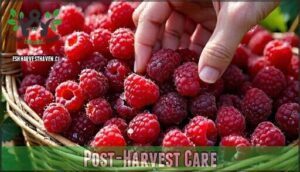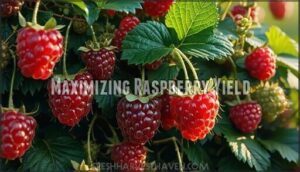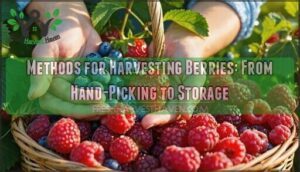This site is supported by our readers. We may earn a commission, at no cost to you, if you purchase through links.

You’ll want to pick those juicy berries on a dry, sunny morning when they’re deep in color and practically slide off the cane at your touch.
Gently cup them—no squeezing, or you’ll end up with more jam than fruit!
Go for shallow containers so they don’t get squished before you pop them into the fridge.
Raspberries are fragile, kind of like your favorite childhood toy, so handle them with care.
Ready to take your raspberry game up a notch? There’s plenty more where that came from.
Table Of Contents
- Key Takeaways
- Harvesting Raspberries
- Choosing Raspberry Varieties
- Pre-Harvest Preparation
- Post-Harvest Care
- Maximizing Raspberry Yield
- Frequently Asked Questions (FAQs)
- What is the best way to harvest raspberries?
- Do coffee grounds help raspberry plants?
- What month are raspberries ready to be picked?
- How to pick out good raspberries?
- Can raspberry plants be grown in containers successfully?
- What companion plants benefit raspberry patch health?
- How do raspberry flavors vary between color types?
- Are there organic methods for deterring birds from berries?
- What is the shelf life of frozen raspberries?
- Conclusion
Key Takeaways
- Pick raspberries in the early morning or cool evenings, and only when they come off the cane with a gentle tug.
- Use shallow containers to keep berries from getting squished, and don’t wash them until you’re ready to eat.
- Keep your plants healthy with regular pruning, good soil, and by watching for pests and diseases.
- Freeze, can, or dehydrate berries right after picking to make that summer flavor last all year.
Harvesting Raspberries
You’re about to step into the tastiest part of growing raspberries—harvest season, where sticky fingers are pretty much guaranteed.
Get ready for delicious chaos—ripe raspberries, stained hands, and sweet rewards straight from the bush.
Timing’s everything here, so get ready to spot those perfect berries and pluck them like a pro before the birds beat you to it.
Timing of Harvest
In the context of raspberry harvesting tips, timing is everything—like waiting for the right punchline.
To master Harvest Scheduling and Berry Selection during the summer harvest, keep these strategies in mind:
- Pick in early morning or cool evenings
- Schedule regular harvesting every 2–3 days
- Forecast yield by checking ripening patterns
- Avoid wet berries
- Start picking as soon as waking ripeness appears
Understanding the best picking raspberry techniques is essential for a successful harvest.
Ripeness Indicators
When you’re eyeing raspberry harvest timing, trust your senses.
Berry color is your traffic light—wait for them to show off a rich red (or purple or gold, depending on type).
Let berry color guide you—only pick when your raspberries flaunt that deep, mouthwatering hue.
Fruit texture? Look for plump, juicy, and not too firm.
Sugar content peaks at full ripeness, so pick when they detach easily—bigger berry size means more sweetness.
Understanding fruit ripening processes is essential for maximizing flavor and yield in homegrown raspberries.
Harvesting Techniques
When it’s raspberry picking time, don’t just grab a bucket and rush in—use smart harvesting techniques!
Head out in the cool morning, gently pull ripe berries with a twist, and always use shallow containers for fruit handling.
Good harvest tools (and maybe a buddy) help you sweep through canes, spotting hidden gems.
Mastery means sweeter, fresher picks every raspberry harvesting season!
Choosing Raspberry Varieties
Picking the right raspberry variety is like match-making for your backyard—you want a good fit, not a summer fling that fizzles out.
Think about your local weather and harvest goals so you’re not left with a handful of sad, sunburned berries (or a bramble jungle for the squirrels).
Summer-Bearing Varieties
When summerbearing raspberries are on your radar, you’re truly in for a treat.
Skip the guesswork and focus on these essentials for juicy summer harvests:
- Opt for summer-specific variety selection for peak fruit quality.
- Watch berry color: deep, even hues mean ripeness.
- Harvest daily to catch prime berries.
- Gentle Raspberry Pruning keeps canes productive.
- Don’t overpack—avoid squished homegrown flavor!
Everbearing Varieties
If you thought summer-bearing was neat, Everbearing Types take raspberry harvesting tips up a notch!
These champs give you a Fall Harvest after their first summer show, delivering sweet berries twice.
With the right raspberry pruning techniques, you’ll boost berry quality and extend picking season.
Variety Selection really matters here for homegrown raspberry care—don’t leave flavor or freedom to chance!
With double the harvest, the importance of proper care and selection becomes clear, emphasizing the need for careful consideration in homegrown raspberry care.
Climate Considerations
Trying to wrestle juicy raspberries from your patch? Don’t ignore climate considerations—regional adaptation’s your secret sauce.
Match varieties to your USDA zone and watch your harvest thrive. Everbearing types shine in steady weather patterns, but all benefit from temperature control, frost protection, and dialed-in soil moisture.
Get those regional planting times right, and enjoy a raspberry harvesting season worth bragging about! Understanding optimal planting times is essential for a successful harvest.
Pre-Harvest Preparation
Before you even start thinking about picking those juicy raspberries, make sure your plants are pruned, healthy, and pest-free—nobody likes finding a surprise caterpillar in their snack.
A little pre-harvest care means you’ll spend harvest day collecting berries, not regrets.
Pruning Methods
Mastery begins with sharp pruning tools and the guts to trim. Here’s how you wrangle those canes:
- Cut old canes to the ground after fruiting—don’t be shy.
- Thin to 6-inch gaps for light and air.
- Try dormant pruning in winter for control.
- Summer pruning keeps things tidy—snip wild growth early.
Effective pruning requires using proper pruning shears to ensure proper pruning. Now, cane management made simple!
Plant Care
A healthy raspberry patch doesn’t just happen—it takes a bit of sweat, some luck, and TLC.
Keep soil health top of mind with compost and mulch for happy roots.
Stick to a regular raspberry watering schedule but don’t drown them.
Mix in smart fertilization for strong growth.
Follow raspberry pruning tips and soil preparation advice for bountiful harvests! To maximize yields, consider implementing proper harvesting techniques for ideal results.
Pest and Disease Management
Once your raspberry plants look happy and healthy, it’s time to keep pests and diseases at bay—think of it as running quality control before harvest.
Try these for smooth sailing:
- Scout early and often for signs of raspberry diseases using keen pest identification skills.
- Use organic methods for pest management and Fungal Control.
- Rotate crops and prune well for superior raspberry disease prevention.
Effective raspberry cultivation involves understanding pest control methods to guarantee a healthy harvest.
Post-Harvest Care
Once you’ve picked your raspberries, how you treat them next makes all the difference between juicy rewards and a mushy mess.
Store them right, skip the pre-wash, and you might even have a few left by the time you reach the fridge—if you can resist snacking on the way!
Storage Methods
Not all berry storage tips are created equal—your fresh haul deserves better than a soggy fridge-bottom sendoff.
Pop them in shallow storage containers, unwashed, in the refrigerator for longer shelf life. Freezing berries? Line them up single-file first.
Dehydration techniques are your secret weapon for snack stash longevity. Quick, clever refrigeration tips save your crop from spoilage!
Understanding proper harvesting methods is essential for maximizing the yield and flavor of your homegrown raspberries, using proper harvesting methods and dehydration techniques for snack stash longevity and clever refrigeration tips.
Handling and Packaging
Once you’ve nailed the right storage methods, it’s time to handle your berries like a pro.
Use shallow berry containers or harvest baskets—no mountain-high piles, unless you like jam before it hits the kitchen.
Gentle fruit handling is the name of the game, choose sturdy storage containers, follow smart packaging tips, and keep crushing to a minimum, ensuring gentle handling of the fruit.
Preservation Techniques
If you’ve packed your raspberries just right, it’s time to think about keeping that summer flavor alive.
There’s more than one way to preserve those sweet gems:
- Try freezing methods with trays and Ziplocs.
- Canning tips for classic jam making.
- Dehydration techniques or freeze drying for snacks.
Pick your favorite storage method and taste sunshine year-round!
Maximizing Raspberry Yield
If you’re dreaming of raspberry bushes so loaded they make your neighbors jealous, you’ve got to give them a little extra TLC right from the soil up.
It’s easier than you’d think—just stick to a few smart habits and your berry bowls might start overflowing before you know it.
Soil and Nutrient Management
Grandma’s garden wisdom still holds true—good soil equals sweet berries.
Master soil testing and pH management for that perfect 5.5–6.5 range.
Nutrient cycling keeps everything humming, but don’t forget regular compost application and the right fertilizer use.
Get your soil prepared properly, and you’ll be singing the praises of organic gardening in no time.
Accurate soil analysis requires using a soil test kit to determine nutrient levels.
| Practice | What It Does | Pro Tip |
|---|---|---|
| Soil Testing | Measures pH, nutrients | Retest yearly |
| Compost Application | Improves fertility | Use aged compost |
| pH Management | Balances acidity | Lime or sulfur helps |
| Fertilizer Use | Feeds canes/roots | Go slow-release |
Watering and Mulching
So, after you’ve got your soil prep dialed, keeping raspberries happy is all about steady Soil Moisture.
Choose Mulch Types that block weeds and keep roots cool—think straw or shredded leaves.
Watering’s best with drip irrigation for slow, deep soaking. Got clay? Invest in well-draining Drainage Systems.
Every patch needs these tricks—hello, Water Conservation, goodbye wilted canes! Employing efficient irrigation methods can also help conserve water.
Regular Harvesting and Maintenance
After getting your mulching in order, keep a basket handy for daily picking—those fresh raspberries ripen fast.
Harvesting every couple of days prevents overripening and keeps the fruit harvesting momentum going strong.
Use a gentle pulling motion so you don’t squish your berry haul.
Good container management means you’re less likely to end up with a mushy mess.
Encourage production, savor freedom, and maintain proper handling to enjoy your fresh raspberries.
Frequently Asked Questions (FAQs)
What is the best way to harvest raspberries?
When the berries are ripe for the picking, gently twist and tug—if they come off easily, you’re golden.
Harvest in the morning, use shallow baskets to prevent crushing, and don’t wash until you’re ready to eat.
Do coffee grounds help raspberry plants?
Coffee grounds can give your raspberry plants a little boost, just don’t dump an entire pot’s worth.
Sprinkle lightly as a mulch—grounds add nutrients, improve drainage, and keep the worms happy.
Too much? That’ll sour the soil.
What month are raspberries ready to be picked?
Think of raspberries as summer’s fireworks—they burst onto the scene mid- to late June or early July, depending on your variety and climate.
When they slip right off the cane at a gentle touch, your picking party’s begun!
How to pick out good raspberries?
Look for ruby-colored raspberries that come off the stem with a gentle tug—no wrestling matches needed!
Skip any mushy or leaky fruits.
If they’re plump, fragrant, and don’t fight back, you’ve struck raspberry gold.
Can raspberry plants be grown in containers successfully?
Growing raspberries in containers is doable—imagine training a wild horse to enjoy a fenced garden.
Choose a large pot, rich soil, and keep them watered.
You’ll tame those brambles and harvest juicy handfuls right at home.
What companion plants benefit raspberry patch health?
Toss in companions like marigolds, chives, garlic, or nasturtiums—these buddies help deter pesky insects, boost pollination, and keep raspberries healthy.
Just don’t let them crowd your patch; everyone needs room to breathe!
How do raspberry flavors vary between color types?
Over 80% of raspberries sold are red, but if you bite into a yellow or black one, you’ll spot the difference.
Yellows are mild and sweet, reds punchy and tart, blacks bring a rich, almost wine-like zing.
Are there organic methods for deterring birds from berries?
You’ve got options—cover bushes with netting, hang shiny objects like old CDs, or try scare tape for some bird deterrent drama.
Don’t be shocked if birds get clever—they’re berry lovers too, just like you.
What is the shelf life of frozen raspberries?
If you pop those raspberries in the freezer right after picking, they’ll keep their top flavor and nutrition for about 12 months.
Just grab a handful when you need a little taste of summer sunshine!
Conclusion
Let’s not sugarcoat it—mastering harvesting tips for homegrown raspberries isn’t just for the green-thumbed elite.
With the right timing, a gentle touch, and a few smart moves, you’ll turn your berry patch into a juicy jackpot.
Remember, keep things light (literally!) and watch those berries disappear faster than socks in a dryer.
Stick with these strategies, and you’ll savor every sweet, homegrown bite—all without breaking a sweat or squishing your precious harvest.
- https://gardenerspath.com/plants/fruit/best-raspberry-varieties/
- https://www.mamanatural.com/red-raspberry-leaf-tea/
- https://www.gardeningknowhow.com/edible/fruits/raspberry/training-trellised-raspberry-canes.htm
- https://ontarioberries.com/
- https://megsediblelandscapes.com/raspberry-plants/raspberry-harvest-season/

